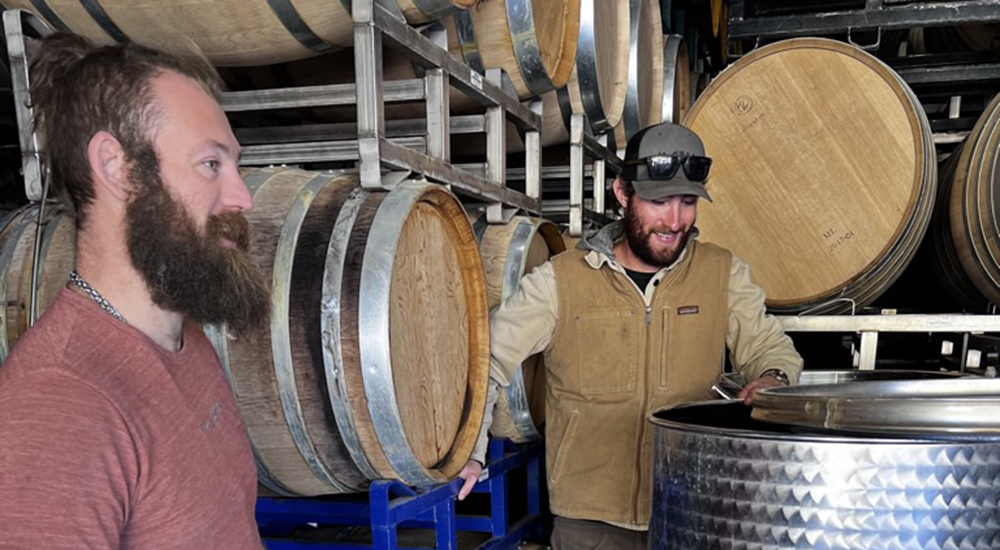
That's a Wrap. What's Next?
by JoAnn Cherry
Another growing season is done and dusted. Grape harvest was the latest on record here at the MAHA Estate. Our first pick this year was on September 19th when we picked Grenache for our Villa Creek Rosé. Each year when one of our Grenache blocks hits that magic brix for rosé wine, our entire team heads out into the vineyard to bring 1-2 tons of Grenache that we send directly to the press. It’s a fun way to kick off harvest, and the result is a fresh, bright Grenache rosé that gets blended with saignée. In 2022, the MAHA fruit was almost all picked by September 10th. How will this later-than-usual harvest affect the wine? A long, cool growing season is almost always preferred. This translates to more time for flavor development and lower sugars. The resulting wines are more complex with less alcohol.

Harvest 2023 is officially coming to a close. So now what? Days are dipping into the 40s, and though we have yet to see frost, it is imminent. We are projected to have another wet winter, which we are thrilled about, but we are keeping our fingers crossed that it actually happens. Getting cover crop seed and compost down is the first order of business in the vineyard post-harvest. It is always our goal to lay these down before the rain comes. Our first storm is usually early in November, which gives us time post-harvest to get the seeds and compost down. This year, with our delayed harvest, it was a little dicey, but the first big rain waited until later in November to fall, giving us a few extra weeks. We got everything laid down just in time for the first rain, which dropped almost 2 inches on the MAHA. That may not seem like much, but in an area where our annual average is around 24 inches, a storm yielding 2 of those is quite significant.

Our home-brewed compost is comprised of grape pomace (what’s left after pressing), garden clippings, and any tree limb shavings from pruning or limb breakage. Each year we truck in organic dairy cow manure to either blend in with our home compost or to apply directly to the soil. This year, due to the confines of a late harvest and our limited crew, we opted to lay the manure down on its own. Time allowing, we will make an additional pass with our own compost, though we try to minimize tractor passes. Compost is a beautiful thing that helps to keep our soil alive and is a critical part of our regenerative system.
Our cover crop mix varies from year to year depending on the needs of the vineyard. This year it’s heavy on daikon radish, which is a nitrogen fixer but also great for penetrating our clay and limestone soils and opening pockets for microbes to inhabit. Clover is always an important ingredient in our cover crop. It is also a nitrogen fixer but, in addition, creates a nice low-growing layer of thatch that protects the surface of the soil from the drying summer sun, in turn contributing to moisture retention. It also prevents noxious weeds like yellow star thistle from breaking through. Maintaining a diverse mix of vegetation in the vineyard creates habitats for beneficial insects. We always include peas, fava beans, and native grasses, providing some nice food for our team and our sheep. Our cover crop is also a critical part of our regenerative system.
Another key component of our winter work is moving the sheep back into the vineyard. During the summer months, you will see our flock of 30 Dorpers roaming the hills surrounding the vineyard. We keep them out of the vineyard during the growing season as grape leaves are one of their favorite things to eat. The benefits of sheep in the vineyard are numerous, the most obvious being their poop. Sheep manure breaks down over time and provides nutrients to the soil microbes and eventually to the vines. Their saliva is beneficial to the vines. Sheep stomachs are great incubators for microbial activity. They transport these beneficial microbes to the vines, the cover crops, and the soil. Even their wool is beneficial as it breaks down and contributes valuable proteins to the soil.
How does regenerative differ from sustainable or organic? Regenerative agriculture is about consistently building the soil up and minimizing depletion. It is contradictory to conventional agriculture, which degrades the soil over time, turning once fertile landscapes into deserts. Non organic fertilizers and pesticides contribute to this degradation by killing the beneficial microbes that keep the soil alive and breathing. Any regenerative system should also practice organic farming. Without the organic component, regenerative is reduced to just sustainable. Unfortunately, sustainable is not enough. We need to constantly rebuild and regenerate. Sustainable agriculture allows for the use of chemical pesticides and fertilizers, so beware when you hear that term, which many consider greenwashing.
Now it's time to hit the slopes, sit in the hot tub, read, and refuel for next year.


